For those of us who study American politics, it’s always a treat when David Shor pops up to offer his insights on the latest election. Shor is a Democratic data analyst who normally stays behind the scenes. In the last election, he helped run a super PAC backing Kamala Harris presidential campaign. Shor, a self-styled socialist, is known for speaking tough truths to Democrats about the state of their party.
Recently, he emerged with not one but two new interviews—one with Eric Levitz of Vox and the other with Ezra Klein of the New York Times. Shor’s data outfit, Blue Rose Research, has conducted extensive post-election analyses about the 2024 election, and he shared some of their key findings in these interviews, findings that will likely surprise a lot of folks.
Below, I highlight some of the most interesting takeaways from these discussions.
1. Politically disengaged voters are becoming more Republican.
Shor first discusses a startling trend in the form of the following two graphics:
I have two graphs: The first breaks down 2024 support by whether or not you had voted in 2020…What you can see here is that in 2020…people who didn’t vote would have been a little bit more Democratic than the country overall had they voted. But over the next four years, people who didn’t vote shifted from being a somewhat Democratic-leaning group to a group that Trump won by double digits.
The second graph here shows, for every precinct, the percentage of people who voted in 2022 and the change in Democratic vote share from 2020 to 2024. What you can see here is that for the lowest-turnout precincts, Trump increased his vote share by about 6 percent, while in the highest-turnout precincts, Harris actually increased her support.
In other words, voters who are far likelier to regularly participate in elections actually voted more Democratic overall in 2024 relative to 2020, but more irregular voters were likelier to swing toward Trump and were a big driver of his win.
2. Relatedly, higher-turnout elections no longer benefit Democrats.
Not long ago, Democrats argued that if they could just get more people to turn out, they would have greater success in elections. Many pointed to Barack Obama’s two wins as evidence of this. In 2008 and 2012, the Obama campaign’s top-notch turnout operation helped propel him to historic victories, as they successfully brought out many “lower-propensity” voters who would often vote for Democrats—if they actually showed up at a polling place. But in the two intervening midterm elections (2010 and 2014), many of these voters—and even more reliable Democrats—stayed home, leading to historic wins for Republicans.
So the thought in some Democratic circles has been that the higher the turnout, the better their party’s chances. However, Shor outlines how this theory doesn’t appear to have much solid grounding:
When you [use more precise data], you see that roughly 30 percent of the change in Democratic vote share from 2020 to 2024 was changes in who voted—changes in turnout. But the other 70 percent was people changing their mind…There were a lot of Democratic voters who were angry at their party last year. And they were mostly moderate and conservative Democrats angry about the cost of living and other issues. And even though they couldn’t bring themselves to vote for a Republican, a lot of them stayed home. But basically, their complaints were very similar to those of Biden voters who flipped to Trump.
The reality is if all registered voters had turned out, then Donald Trump would’ve won the popular vote by 5 points [instead of 1.7 points]. So, I think that a “we need to turn up the temperature and mobilize everyone” strategy would’ve made things worse.
The Blue Rose chart below shows that if only people who had voted in the 2022 midterms—a lower-turnout election in which Democrats did relatively well—had voted last year, Harris would have won the popular vote and also the Electoral College fairly easily. However, if those who stayed home in 2024 had all turned out, Trump likely would have won by an even greater margin than he did, and Democrats would almost certainly be in a deeper hole in the House and Senate.
3. Trump’s win was due in no small part to substantial gains with racial minorities.
According to Shor:
If we look at 2016 to 2024 trends by race and ideology, you see this clear story where white voters really did not shift at all. Kamala Harris did exactly as well as Hillary Clinton did among white conservatives, white liberals, white moderates.
But if you look among Hispanic and Asian voters, you see these enormous double-digit declines. To highlight one example: In 2016, Democrats got 81 percent of Hispanic moderates. Fast-forward to 2024; Democrats got only 57 percent of Hispanic moderates, which is really very similar to the 51 percent that Harris got among white moderates.
…[W]hite people only really started to polarize heavily on ideology in the 1990s. Now, nonwhite voters are starting to polarize on ideology the same way that white voters did.
The swings were a little less clear for black Americans overall, but Blue Rose’s polling before Biden dropped out of the race found that blacks were “poised to swing 7 to 8 percentage points against [the Democrats].” Shor added:
As to whether this is inevitable, I would say that to some degree getting 94 percent of any ethnic group is unsustainable. But I think the losses that we’re seeing among nonwhite voters and immigrants is symptomatic of this broader, ideological polarization that Democrats are suffering from.
Another way of interpreting this data: race is becoming less of a determining factor in how Americans vote, whereas ideology has become a greater predictor.
Perhaps even more startling for many Democrats, immigrant voters are becoming more Republican-leaning too. In fact, Trump appeared to narrowly carry immigrant voters last year, and Shor argues that, astoundingly, roughly half of the net votes that Trump received in 2024 likely came from immigrants.
Democrats looking for signs of hope out of this might be able to argue that inflation, which was a unique factor in the 2024 election, scrambled things for voters across a host of demographic lines. But it’s not clear that, moving forward, these voters will be immediately open to voting for Democrats, either—not without hard work.
4. Young voters also appear to have swung heavily toward Trump.
Though Democrats have long assumed the support of younger voters, especially since Obama first came onto the national scene, that support now appears to be far less solid. Some of Shor’s data on this front is nothing short of shocking (emphasis below is mine):
[T]he single biggest predictor of swing from 2020 to 2024 is age. Voters under 30 supported Biden by large margins. But Donald Trump probably narrowly won 18- to 29-year-olds. That isn’t what the exit polls say. But if you look at our survey data, voter file data, and precinct-level data, that’s the picture you get.
And if you look at people under the age of 25, every single group—white, nonwhite, male or female—is considerably more conservative than their millennial counterparts. And it even seems that Donald Trump narrowly won nonwhite 18-year-old men, which is not something that has ever happened in Democratic politics before.
He added:
There’s also this enormous amount of gender polarization. If you look at the gender gap—just what fraction of the vote Kamala Harris got versus what fraction of the vote Donald Trump got among men and women—for voters over the age of 30, there was about a 10 percent gender gap between men and women. And that’s, roughly speaking, where it’s been in American politics for most of the last 20 years.
But if you look at voters under the age of 25, the gender gap has doubled in size. And if you look at 18-year-olds specifically, 18-year-old men were 23 percentage points more likely to vote for Donald Trump than 18-year-old women.
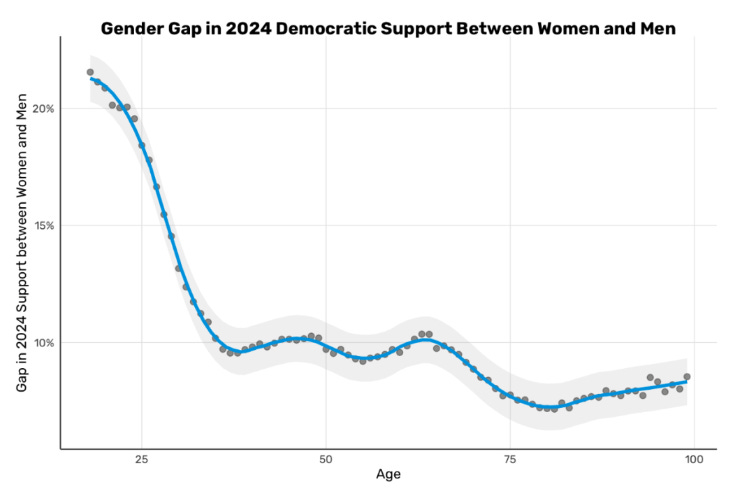
Shor offers a couple of theories for why America’s youngest voters have shifted toward the Republicans:
Yair Ghitza has an incredible paper that shows that people have formative political years. And you can predict a lot of how conservative someone will be from how popular the incumbent president was when they were teenagers or when they were in their 20s. And so I think that’s definitely true and it’s definitely part of the story. But I think that there’s more to the story than that.
If you look at the millennials, the millennials were more left-wing in a bunch of countries—Canada, the UK, and Europe. I think that there’s a story you can tell: Baby boomers were an incredibly left-wing generation in most places in the world. And millennials were their kids.
But Gen X was really quite a bit more conservative than the Boomers in most countries. And there’s a lot of theories you can make about that—response to the oil shocks, stagflation, neoliberalism. But whatever the reason, Gen X came out more conservative. So I think that part of the story is simply that the current crop of young people had Gen X parents.
We are now far removed from the idea that “demographics are destiny” for the Democrats. There does not appear to be some rising demographic majority, as many left-leaning organizations I’ve worked with in the past believed, of young people, racial minorities, and others who will deliver Democrats sustained electoral success for the foreseeable future. At this point, the party can’t really afford to take any group of voters for granted.
5. Democrats currently face a brutal “issue” landscape.
One way that parties try to win elections is by running on issues they think will mobilize voters to their side. Specifically, they often try to take advantage of issues where voters trust them more than the other party. Unfortunately for Democrats, the number of issues on which voters both currently trust them over Republicans and prioritize those issues in their vote choice is staggeringly small. Their best issue, on which they enjoy a smaller advantage than they have historically, is healthcare. Voters also trust Democrats more than Republicans on climate change/the environment and abortion, but they simply don’t prioritize those issues over others at the ballot box.
Voters’ top issues? Exactly what virtually every pre-election poll foretold: inflation, the cost of living, and the economy more broadly. On all three, Republicans are trusted to a far greater degree. They also have an advantage on several other key issues, including taxes, crime, immigration, and border security.
This runs counter to the arguments of some of Democrats’ more progressive critics, who said that for Democrats to have electoral success, they needed to boost engagement with young, a group they argued cared primarily about the environment, student debt, and the Israel-Hamas war. But as the above chart demonstrates, these issues rarely factor into most voters’ decisions when they cast a ballot (especially student loans). Moreover, pre-election polling showed that all three of these issues were at the bottom of young people’s list of priorities.
For Democrats to make a comeback in the years ahead, they need to eat into Republicans’ advantage on the issues voters care most about. As I’ve written elsewhere, they should have ample opportunities to fight Trump and the Republicans on inflation and the economy.
And indeed, Shor’s data shows that Trump’s popularity has begun waning, and that Democrats should have some opportunities to pick fights with him on several of those aforementioned issues.
Trump’s approval rating has dropped since he took office. His ratings on his handling of the economy, which historically was a strong suit for him, have dropped the most, and his handling of cost of living has also gone down by quite a bit. And Elon Musk has become much more unpopular and is now the most unpopular member of his administration by a good deal. Trump and Elon have really spent the first part of their term diving into the biggest weaknesses of the Republican Party—namely, they’re trying to pass tax cuts for billionaires, they’re cutting essential services and causing chaos for regular people left and right, while trying to slash social safety net programs. It’s Paul Ryan-ism on steroids.
As for specific policies Democrats could fight him on, Shor’s data points to Trump’s tax cuts and tariffs as well as threats from DOGE to entitlement programs like Social Security, Medicare, and Medicaid.
6. Democrats must contend with the fact that America is a center-right country.
This is something I have written about extensively elsewhere. Shor explains:
Fundamentally, 40 percent of the country identifies as conservative. Roughly 40 percent is moderate, 20 percent is liberal, though it depends exactly how you ask it. Sometimes it’s 25 percent liberal. But the reality is that, to the extent that Democrats try to polarize the electorate on self-described ideology, this is just something that plays into the hands of Republicans.
This doesn’t, however, mean that only 20 percent of the country supports the liberal view on all issues. In fact:
If you look at moderates—and especially nonwhite moderates—a bunch of them hold very progressive views on a variety of economic and social issues. A very large fraction of Trump voters identify as pro-choice. We’ve seen populist economic messaging do very well in our testing with voters of all kinds.
But Shor offers some key warnings for Democrats, and specifically for their more liberal-leaning voters:
I think that there are also some big cultural divides between highly educated people who live in cities and everybody else. And to the extent that we make the cultural signifiers of these highly educated people the face and the brand of our party, that is going to make everyone else turn against us.
And:
It’s not just that the New York Times readers are more liberal than the overall population—that’s definitely true. It’s that they’re more liberal than they were four years ago—even though the country went the other way.
The country’s center-right tilt has also made it especially difficult for Democrats to have sustained success in the U.S. Senate, the body of Congress that, among other things, is responsible for confirming presidential appointments to the Supreme Court. Even in 2018 and 2020, two great years for Democrats, they struggled to make gains in the upper chamber, and following 2024, they are now under majority status by three seats (or four if you take into account the fact that Republicans have the tie-breaking vote). Worse still, the path toward regaining the majority looks difficult.
Shor outlines what voters seem to want from Democrats moving forward: moderating on the culture war while speaking to people’s economic pain and desire to improve their material conditions. Blue Rose’s polling routinely found that inflation was the top issue, and also showed that voters who were frustrated about the economy were overwhelmingly looking for a “shock to the system.” Given that Harris was seen as the candidate defending the system and Trump was the one rebelling against it, it’s not hard to see how America delivered the outcome it did.
Shor believes Democrats must speak directly to Americans’ economic discontent to have a chance in swing or even red states where they’ll need to be competitive to win back the Senate—and make gains in other downballot offices—anytime soon.
7. Ideology matters—and voters perceived Democrats as too liberal.
Flowing from some points above, this chart is worth highlighting:
Since at least 2016—and likely stemming back to Obama’s campaigns as well—the presidential candidate whom voters perceived to be ideologically closer to the median voter has won every time. Last year, it was Trump.
Many Democrats will surely protest this characterization of Trump, but it’s important to consider that there is a difference between being reactionary and being ideologically conservative. Trump—at least the candidate—eschewed Republican orthodoxy on everything from gay marriage to abortion to entitlement programs, which clearly gave some swing voters an opening to support him. His willingness to use and abuse the levers of government to his own benefit is anathema to principled conservatism.
The takeaway here builds on the above idea that Democrats would likely benefit from moderating on cultural-war issues, especially if they want to be competitive at the national level in a center-right country.
Editor’s note: A version of this piece first appeared in the author’s personal Substack.






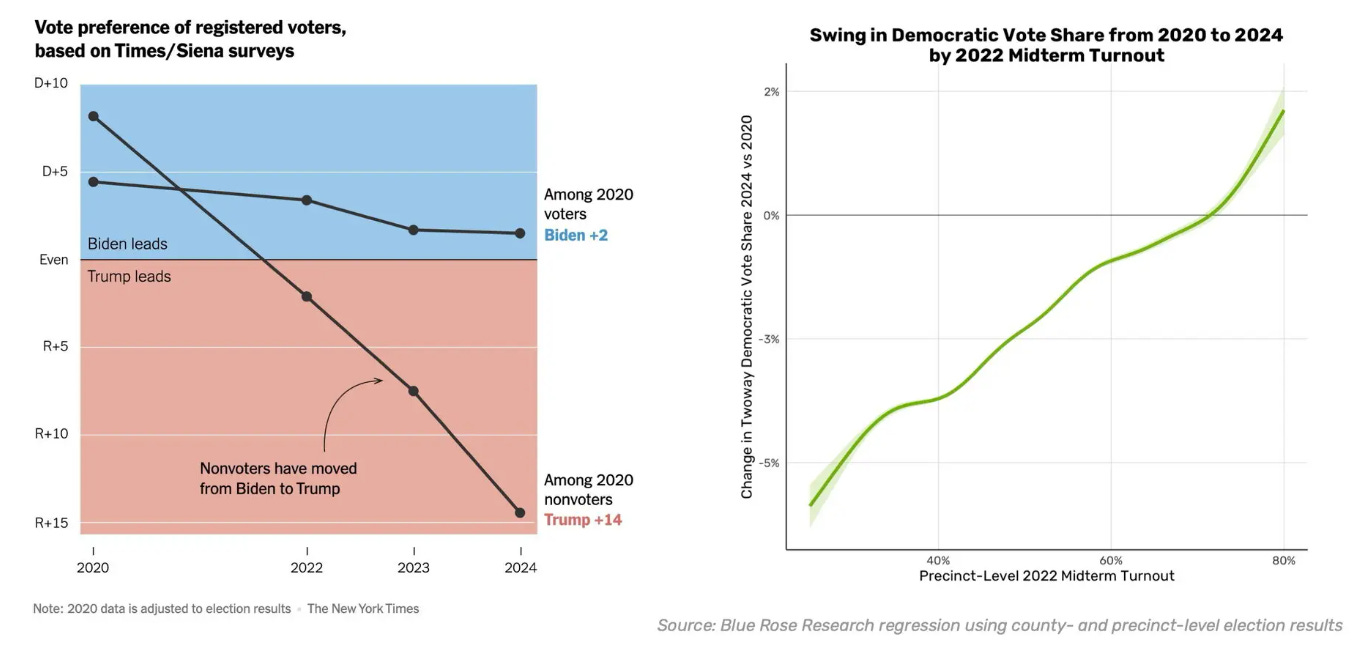
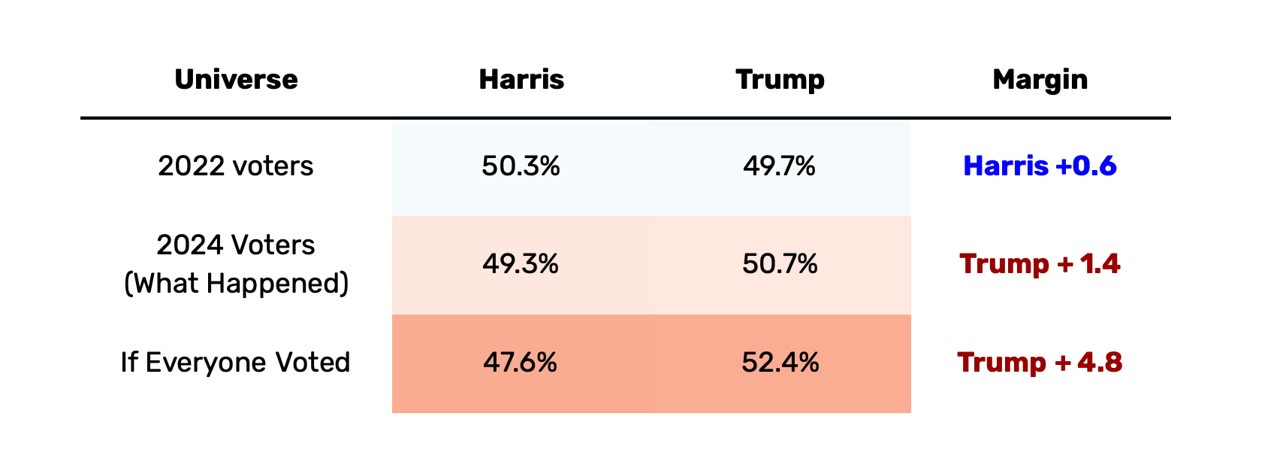
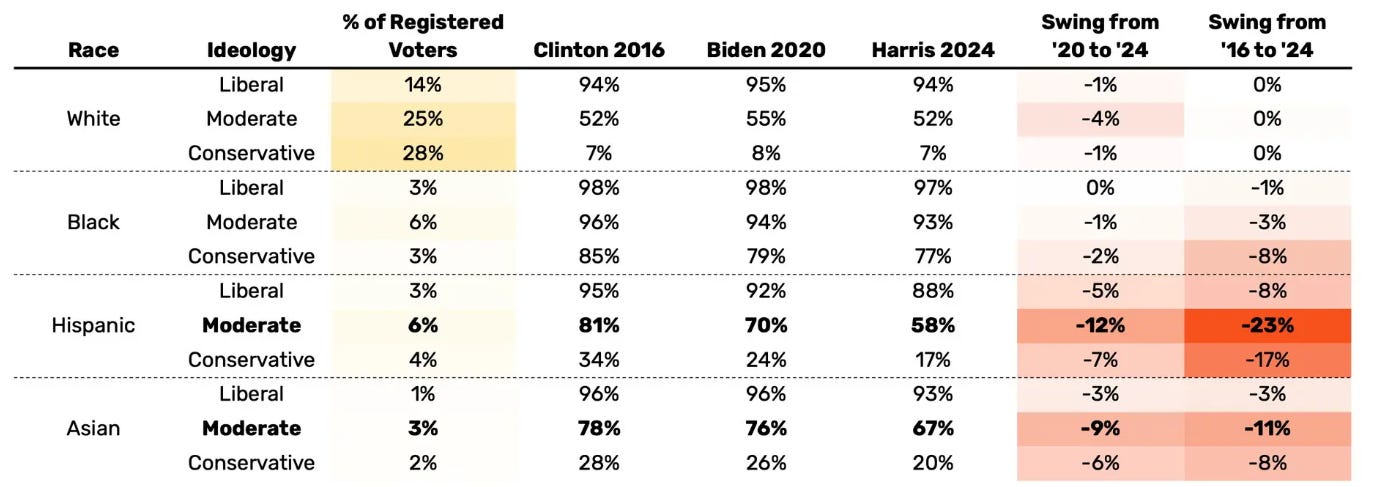
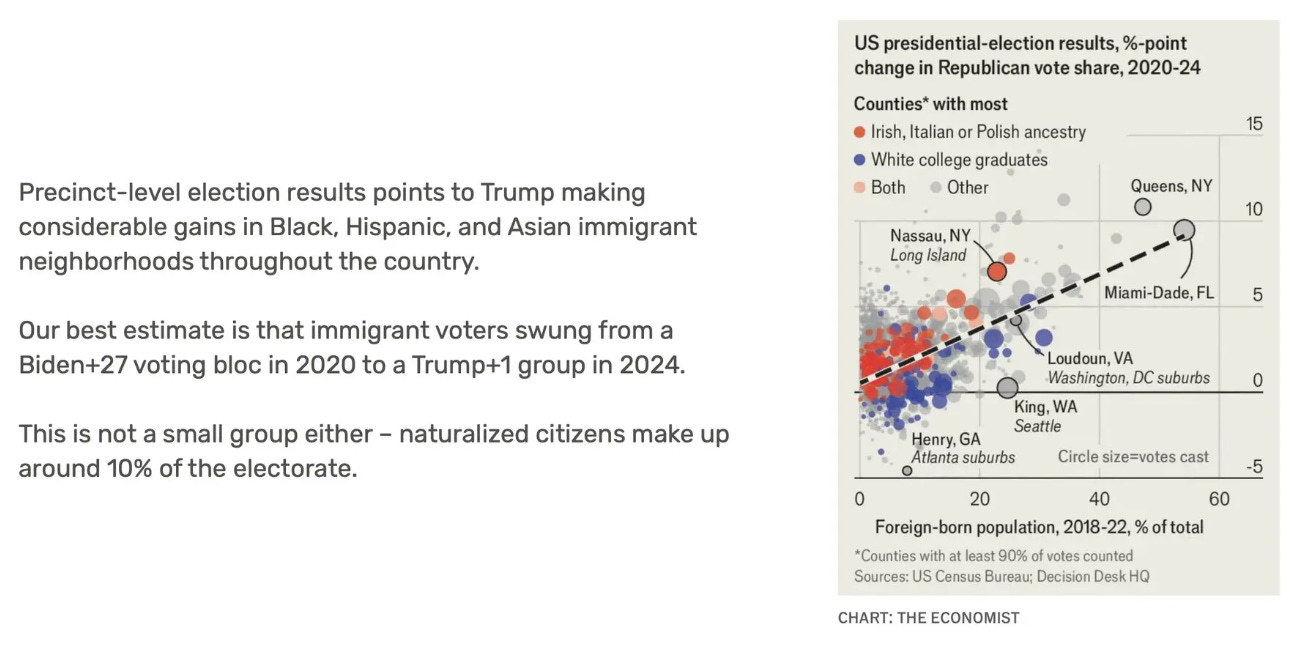
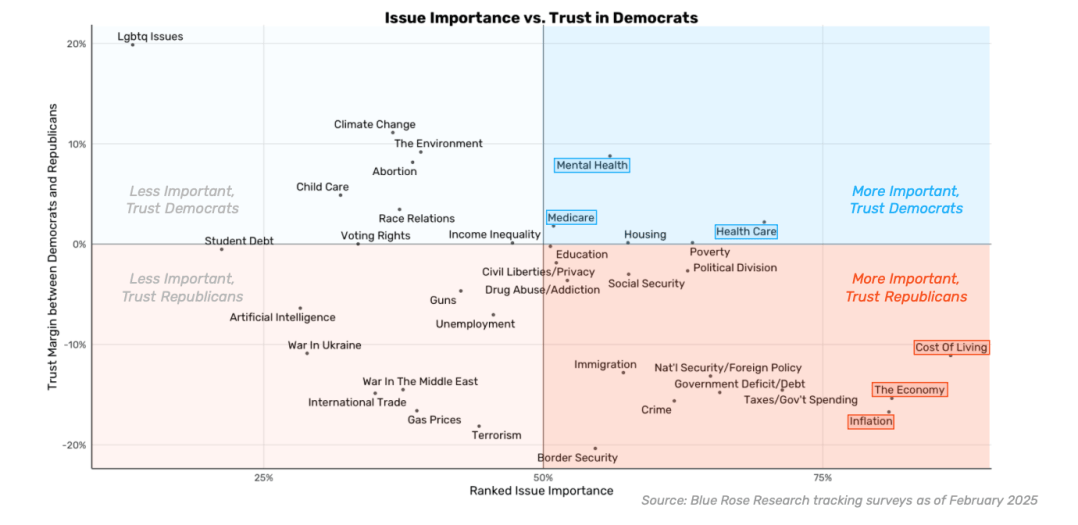
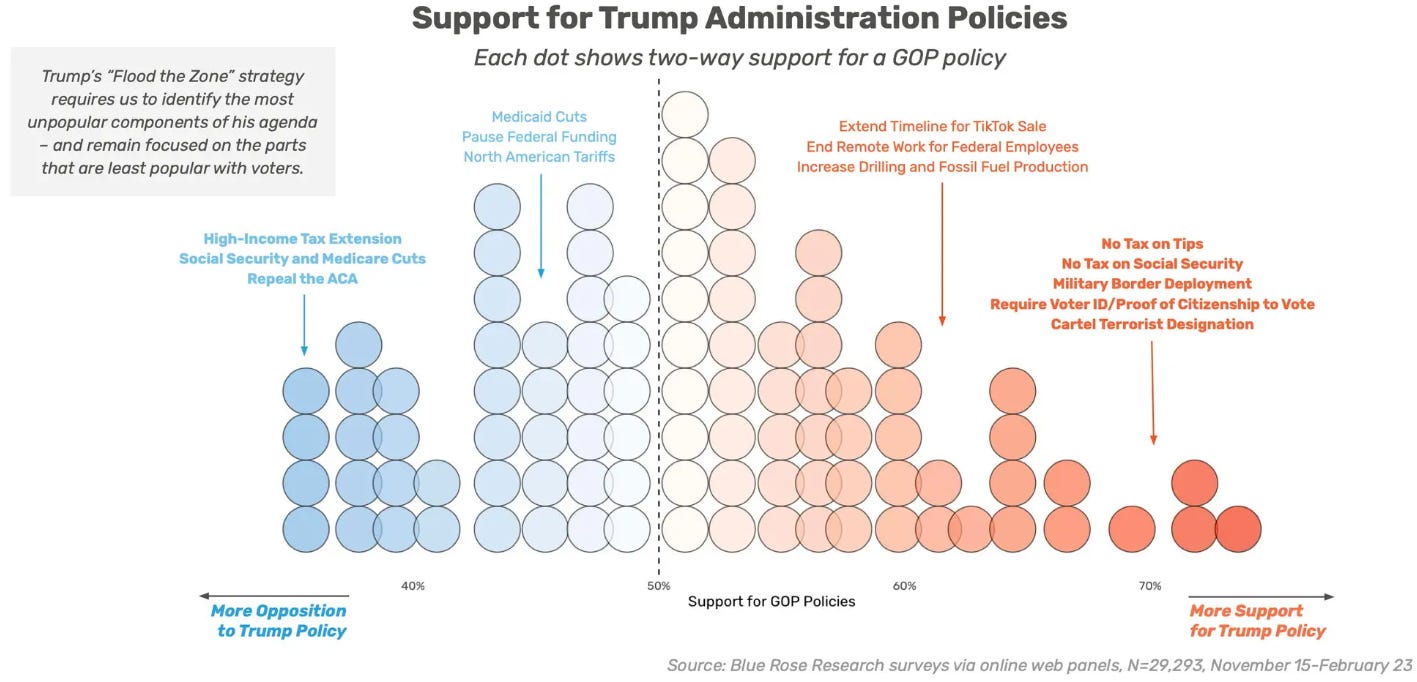

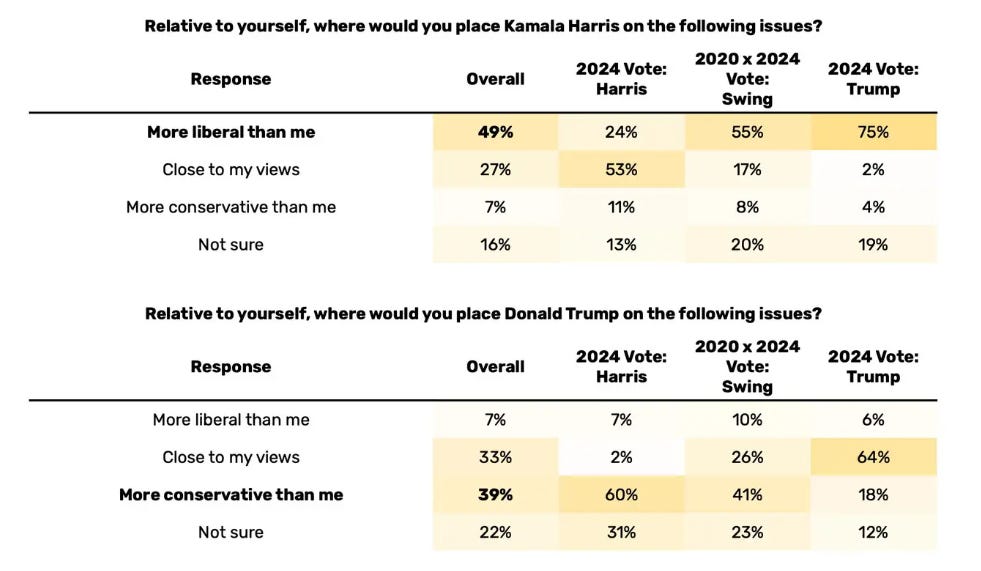
Dems seem to be unable to grasp how much damage dissolving the Southern Border inflicted on the Party, and the country. Even pro open borders voters, must have wondered about the wisdom of waving in 10 million unvetted souls, without a single extra housing unit, doctor or bilingual teacher .
Mostly impoverished and sparsely educated, it will not matter how hard migrants are willing to toil. The vast majority will never be able to afford life in a high cost country like the US, without massive and permanent subsidies.
Soon, all federal safety nets will end, just as billions in NGO money evaporates, seemingly overnight. Blue States might replace the federal programs, with State subsidies. Red States will not. This will result in migrants loosing subsidized housing, food and healthcare. The result will likely be, homelessness and poverty on a level, unseen in the US since the DustBowl. Many migrants will move to Blue States, or relocate to nations where they can afford to eat and sleep.
Millions of migrants were manipulated by Dems to relocate to a place that was not prepared for them, and whose cost of living was far too high, for their education and skill level. In the meantime, Working Class and Blue Collars Americans, watched their wages plummet, as the cost of affordable housing soared, and their already failing schools, were doused in non English speaking kids, some lacking any previous formal education.
It is not that Dems do not know why their approval rating is at 27%, it is that they will not admit their largest failure. For attempted political gain , they ruined the lives the millions of migrants, and killed the living standards of Working Class and Blue Collar American workers. All before anyone mentions the violent crime and drugs, they knowingly imported, in pursuit of single party rule. The above stats are academically interesting, but Dems do not need more political autopsies, but a Reformation, or maybe an Exorcism.
Trying to figure out which issues will help thwart Trump is a losing game. Figure out which issues will buoy the working and middle classes. And believe in them.